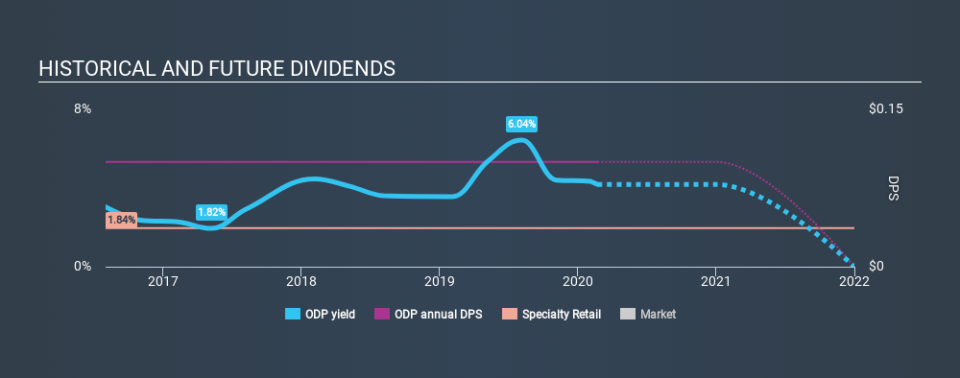Interested In Office Depot, Inc. (NASDAQ:ODP)’s Upcoming 1.0% Dividend? You Have 4 Days Left

Office Depot, Inc. (NASDAQ:ODP) stock is about to trade ex-dividend in 4 days time. Ex-dividend means that investors that purchase the stock on or after the 28th of February will not receive this dividend, which will be paid on the 13th of March.
Office Depot's next dividend payment will be US$0.025 per share, and in the last 12 months, the company paid a total of US$0.10 per share. Calculating the last year's worth of payments shows that Office Depot has a trailing yield of 3.9% on the current share price of $2.55. Dividends are a major contributor to investment returns for long term holders, but only if the dividend continues to be paid. As a result, readers should always check whether Office Depot has been able to grow its dividends, or if the dividend might be cut.
See our latest analysis for Office Depot
If a company pays out more in dividends than it earned, then the dividend might become unsustainable - hardly an ideal situation. Office Depot paid out 182% of profit in the past year, which we think is typically not sustainable unless there are mitigating characteristics such as unusually strong cash flow or a large cash balance. Yet cash flow is typically more important than profit for assessing dividend sustainability, so we should always check if the company generated enough cash to afford its dividend. Over the last year it paid out 63% of its free cash flow as dividends, within the usual range for most companies.
It's good to see that while Office Depot's dividends were not covered by profits, at least they are affordable from a cash perspective. If executives were to continue paying more in dividends than the company reported in profits, we'd view this as a warning sign. Very few companies are able to sustainably pay dividends larger than their reported earnings.
Click here to see the company's payout ratio, plus analyst estimates of its future dividends.
Have Earnings And Dividends Been Growing?
Stocks in companies that generate sustainable earnings growth often make the best dividend prospects, as it is easier to lift the dividend when earnings are rising. Investors love dividends, so if earnings fall and the dividend is reduced, expect a stock to be sold off heavily at the same time. That's why it's comforting to see Office Depot's earnings have been skyrocketing, up 21% per annum for the past five years.
Many investors will assess a company's dividend performance by evaluating how much the dividend payments have changed over time. It looks like the Office Depot dividends are largely the same as they were four years ago.
To Sum It Up
Is Office Depot an attractive dividend stock, or better left on the shelf? Office Depot has been growing its earnings per share nicely, although judging by the difference between its profit and cashflow payout ratios, the company might have reported some write-offs over the last year. It might be worth researching if the company is reinvesting in growth projects that could grow earnings and dividends in the future, but for now we're not all that optimistic on its dividend prospects.
Wondering what the future holds for Office Depot? See what the four analysts we track are forecasting, with this visualisation of its historical and future estimated earnings and cash flow
A common investment mistake is buying the first interesting stock you see. Here you can find a list of promising dividend stocks with a greater than 2% yield and an upcoming dividend.
If you spot an error that warrants correction, please contact the editor at editorial-team@simplywallst.com. This article by Simply Wall St is general in nature. It does not constitute a recommendation to buy or sell any stock, and does not take account of your objectives, or your financial situation. Simply Wall St has no position in the stocks mentioned.
We aim to bring you long-term focused research analysis driven by fundamental data. Note that our analysis may not factor in the latest price-sensitive company announcements or qualitative material. Thank you for reading.

